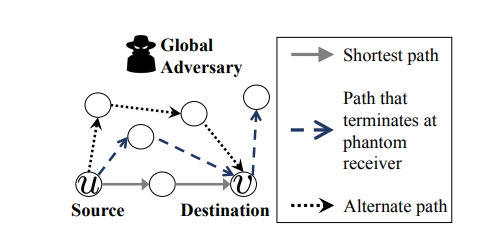Optimal Privacy-Preserving Probabilistic Routing for Wireless Networks
Objective
The objective of this project is a statistical decision-making framework to optimize the privacy-utility trade-off for routing in wireless networks against a global and informed adversary using the Bayesian maximum-a-posteriori (MAP) estimation strategy. We then formulate linear programs to efficiently compute the optimal privacy-preserving paths under the lossless and loss adversarial models, given a privacy budget.
Abstract
In the optimal privacy-preserving probabilistic routing for wireless networks project, Privacy-preserving routing protocols in wireless networks frequently utilize additional artificial traffic to hide the source-destination identities of the communicating pair. Usually, the addition of artificial traffic is done heuristically with no guarantees that the transmission cost, latency, etc., are optimized in every network topology.
In this project, we explicitly examine the privacy-utility trade-off problem for wireless networks and develop a novel privacy-preserving routing algorithm called Optimal Privacy Enhancing Routing Algorithm (OPERA). OPERA uses a statistical decision-making framework to optimize the privacy of the routing protocol given a utility (or cost) constraint. We consider global adversaries with both lossless and loss observations that use the Bayesian maximum-a-posteriori (MAP) estimation strategy. We formulate the privacy-utility trade-off problem as a linear program which can be efficiently solved.
Keywords: Location Privacy, Privacy-Utility Trade-Off, Probabilistic Routing, Bayesian Traffic Analysis, Wireless Routing.
NOTE: Without the concern of our team, please don't submit to the college. This Abstract varies based on student requirements.
Block Diagram

Specifications
HARDWARE SPECIFICATIONS:
System: Pentium IV 2.4 GHz.
Hard Disk: 40 GB.
Floppy Drive: 1.44 Mb.
Monitor: 15 VGA Colour.
Mouse : Logitech.
Ram: 512 Mb.
SOFTWARE SPECIFICATIONS:
Operating system: Windows XP/7/LINUX.
Implementation: NS2
NS2 Version: NS2.2.34
Front End: OTCL (Object Oriented Tool Command Language)
Tool: Fedora (To simulate in Linux OS)
Learning Outcomes
- What is Tomcat server and how they can work?
- What is Wireless Sensor Networks?
- What is Optimal Privacy Preserving?
- What is Probabilistic Routing?
- What type of technology versions is used?
- Data Parsing Front-End to Back-End.
- Need of Eclipse-IDE to develop a web application.
- Working Procedure.
- Testing Techniques.
- Error Correction mechanisms.
- How to run and deploy the applications?
- Introduction to basic technologies used for.
- How project works?
- Input and Output modules.
- How to test the project based on user inputs and observe the output?
- Practical exposure to software tools and solution providing for real time problems working with team/ individual work on Creative ideas.
- Learn about types of algorithms and how to use?
- Project Development Skills:
- Problem analyzing skills.
- Problem solving skills.
- Creativity and imaginary skills.
- Programming skills.
- Deployment.
- Testing skills.
- Debugging skills.
- Project presentation skills.
- Thesis writing skills.





 Paper Publishing
Paper Publishing
